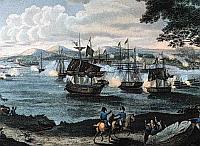
Battle of Plattsburgh
One year and one day after the Battle of Lake Erie, an American squadron, under the command of Master Commandant Thomas Macdonough, defeated the Royal Navy on Lake Champlain in a bloody battle at Plattsburgh Bay. The Battle of Plattsburgh turned back an invasion force of 11,000 British troops which was intended to do nothing less than redraw the map of the United States. Like the Battle of Lake Erie, the Battle of Plattsburg was fought in fresh water hundreds of miles from the ocean. It was not a large fleet battle, and yet, was probably the most important naval victory of the war.
The War of 1812 was ending. British and American negotiators were working on a the peace treaty in the Belgian city of Ghent. Nevertheless, the British still wanted to punish the Americans. With the abdication of Napolean, the British sent an additional 16,000 troops to America. On August 31, 1814, 11,000 British troops marched south into New York state. The only American troops ready to face them were around 1,500 regulars, many old and infirm, at the village of Plattsburg on Lake Champlain. “Uti possidetis” is a principle in international law that states that at the end of a war, territory remains in hands of those who control it, unless otherwise provided for by treaty. If the British could sweep the Americans aside at Plattsburgh and occupy a significant swath of American soil, they could give vast leverage to their negotiators in Ghent to dictate the terms of the settlement.
Before the British forces, under the command of Lieutenant-General Sir George Prévost, launched their attack on Plattsburg, Prévost sent a Royal Navy squadron to clear the American Navy from Lake Champlain. Without control of the lake, the British lacked a supply line to support the invasion.
The American and British squadrons were of roughly equal size, though the British had the advantage in “long guns” with greater range. To counter this, Macdonough pulled his ships back into Plattsburgh Bay, where the British would be forced to engage at close range, allowing the Americans to take full advantage of their short-range carronades. He anchored his ships in a line from north to south and waited for the British squadron under the command of Commodore George Downie to arrive. Macdonough’s flagship was the 26 gun corvette, Saratoga. The rest of the American squadron was made up of the 20 gun brig Eagle, the 17 gun schooner Ticonderoga and the 7 gun sloop Preble. Downie was in command of the 36 gun frigate Confiance, the 16 gun brig Linnet, and the 12 gun sloop Finch. The Americans also had 10 gun boats, the British, 12.
At the Battle of the Nile, Nelson and his cadre of highly skilled captains destroyed a French fleet anchored in a defensive position, by sailing on both sides of the line. The British squadron at Plattsburgh attempted the same tactic, but failed due to light winds, American gunboats blocking gaps in the American line and Macdonough’s skillful positioning of his ships. All American ships were rigged with spring lines on their anchors allowing the ships to be turned to direct their broadsides at the British. Macdonough also had the Saratoga rigged with kedge anchors which allowed him to turn his ship completely around. After a long and bloody exchange of fire in which both the Saratoga and the Confiance were seriously damaged and Commodore Downie had been killed, Macdonough ordered his anchors to be cut and the kedge anchors hauled so that the Saratoga presented her undamaged port side to the British. The Confiance, which had lost several officers in addition to Commodore Downie and was barely able to return fire, surrendered, followed shortly thereafter by the rest of the British squadron. Historians of the day referred to the battle as the “False Nile.”
When Prévost learned of the Royal Navy defeat at Plattsburgh Bay, he abandoned his attack on Plattsburg and marched his troops back to Canada. Three days later the British attack on Baltimore also failed at the siege of Fort McHenry. In Ghent, the American negotiators used the victory at Plattsburg to demand exclusive rights to Lake Champlain and to deny the British exclusive rights to the Great Lakes as well as to end the British attempt to establish a buffer zone between the United States and Canada.
Plattsburg is only about five miles from Valcour Island in Lake Champlain, where an American fleet under the command of Benedict Arnold were routed by a British fleet on October 11, 1776. While the battle was an American defeat, it delayed the British move down Lake Champlain for a year. When the British under General Burgoyne did invade in 1777, they were defeated by a newly formed Continental Army at Saratoga. The victory at Saratoga lead France to join the war on the side of the Americans, leading ultimately to the loss of a second British Army at Yorktown in 1781. The Battle of Valcour Island is considered by many to be the defeat that won the war.

Archaeologists scramble to 3-D map Civil War shipwreck off Galveston
Alerted to changing conditions by a Houston photographer, an archaeology team is working against the clock off Galveston to get a 3-D record of the remains of the Hatteras, an iron-hulled Union gunboat sunk by the South on Jan. 11, 1863. http://blog.sfgate.com/hottopics/2012/09/10/archaeologists-scramble-to-3-d-map-civil-war-shipwreck-off-galveston/
Pingback: The Two Most Important Naval Victories of the War of ... - Old Salt Blog
Thanks for this well presented account of this critical battle. Very succinct and well-written!
You should put more info
~SF
Good work!
~BT
Great work!
~TT